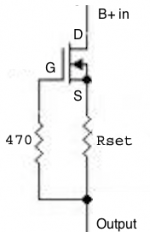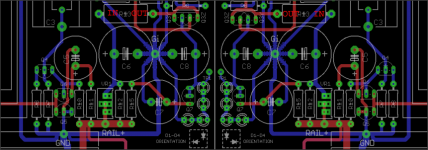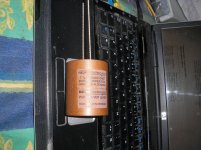The voltage across the first stage's load resistor R4 falls in reality when you see TP1-TP1 climbing during warm up. So it starts above center and gradually centers between Vpk-Vpk max. I.e. there is bias from the get go.I tried a little experiment tonight. I turned on my amps/speakers, preamp, and turntable, put a record on, then turned on the FSP while cold (very cold). I waited a few seconds (imagining LEDs turning on inside the case) then selected the associated input on my DCB1. In retrospect I should have played a couple of CD's or something first, to warm up the DCB1 and the power amps in my speakers. I wanted to determine whether I could hear the FSP warm up. Measurements told me that the TP1-TP2 voltage starts negative for a minute or so, then slowly climbs and takes at least 20 minutes to get to our target 3.6V. I wasn't looking for a fault, just wondering how it changes as it warms.
I listened to a record I know well, although perhaps not well chosen for this experiment since John McLaughlin's guitar is already distorted, but I initially thought it sounded a little more distorted than usual, although not horribly. It was very listenable. Bass seemed a bit weak. After about 20 minutes (half way through the second side) it seemed like the gain had increased a few dB, and the bass in particular seemed to gain extension and power. Treble also seemed to improve, but then it would seem that way if in fact the gain had changed a bit. I started with side two of John McLaughlin's "Electric Guitarist", then played side one, where I started to hear an improvement, then went back to side two again (never touched the volume control). The improvement was definite - cleaner sounding, more extended frequency response in both bass and treble, and noticeably more "power" in the bass (Jack Bruce on "Are You the One?" sounded a lot better the second time around) and percussion.
I must try this again after warming up the rest of the system first, to see how much of the change is the FSP vs. the rest of the electronics.
BTW, I'm starting to like this Sumiko LMS cartridge -- I have always avoided conical stylii, but this little bugger seems to track pretty well and has good focus. Not "high end" but sounds better than I expected. Also more tolerant of setup (VTA etc) than more aggressive stylus profiles, while perhaps not getting the most out of the groove.
One other note: tonight I happened to have my ear right beside the mid/tweeter of one speaker for a moment, and heard... voices! Some RF stuff, I don't know whether it was radio or TV. Could not make it out, and could not hear it at all even a few cm from the speaker. Tried selecting other inputs to the preamp and couldn't hear it, so it was coming from the phono inputs. I'll listen again some day with the TT not connected; I *expect* this is coming from the cartridge or the TT wiring.
20mins ain't something too long in a context of a whole system settling for temp vs. best sound IMO, it usually takes an hour especially with richly biased power amps or any vacuum tubes in the chain.
If it still bugs you, there is the active CCS path to follow. Not that complex a modification (for MC,LMC versions ONLY. MM,HMC do not care due to good Tempco high R2 control):
Use a Supertex DN2540 (TO-220 version) set it at 18mA for two 369s. Needs two resistors, one gate stopper 470R & one to find its exact value that programs IDSS on a breadboard 20VDC test for each different Vgs(OFF) DNMOS sample. A 100R trimmer in rheostat mode may help you define it. Make those three parts into a two legged in-out thing and solder it upright substituting R13. Revisit TP1-TP2 setting. Then the 369s will have the designed bias irrelevant to their positive Tempco from the moment you flick the "ON" switch. DNMOS give their own hiss contribution but you can judge if it will be audible in your system context and phono gain.
If you got RFI ingress in your installation, you can either use: A. Ferrite bead usually in a place like input cable PCB side hot, 369s gate legs. B. 1uH inductor in series with signal to a high impedance point (looks like a resistor). C. 10nF cap from input RCA ring direct to chassis within very short distance.
*All the discussed above solutions from active CCS bias to signal RFI countermeasures are additions that may prove also audible for the better or worse.
Attachments
It's not bugging me, I was just curious to see what changes I could hear as it warmed up, and though others might find it interesting too. I was actually very pleased that it got as good as it did so quickly -- as you say, an hour or so warm-up is not unusual. Since I had measured the current through the source resistors when fairly cold, I was surprised by the apparent small change in gain, although of course I have no numbers to back up that impression. It just seemed a little louder after twenty or thirty minutes.
The CCS is intriguing, but as you said before introduces some noise, which in a high-gain configuration is probably not a good idea. As for RF, I'm not too worried about it. It was very faint, inaudible from any distance away. I suspect my rewiring job on the tonearm is to blame -- I gently twisted the tonearm wire pairs and ran them all the way to RCA's on the TT chassis. If I ever get around to replacing that part with some nice flexible shielded cable I bet that will make a difference.
The CCS is intriguing, but as you said before introduces some noise, which in a high-gain configuration is probably not a good idea. As for RF, I'm not too worried about it. It was very faint, inaudible from any distance away. I suspect my rewiring job on the tonearm is to blame -- I gently twisted the tonearm wire pairs and ran them all the way to RCA's on the TT chassis. If I ever get around to replacing that part with some nice flexible shielded cable I bet that will make a difference.
edit for complete explanation:
Those 369 JFETs add little Id with temp rise. The higher the Rs the more difficult for the Id to rise, the less gm is gained with temp. Thus LMC,MC are more susceptible since we keep R2,3 low for extra noise avoidance. Then the BJT cascode will translate enhanced gm=dId/dvgs after Tc settling through dId of Rd (R13) modulating its emitter bias to some little more AC voltage across R4. I.e. your somewhat louder impression after your LMC settling time has passed is correct.
As for new post accident cart, since you got the high gain build, get an AT33PTG//II LMC from Japan in the 400-450 dollar region sans import tax, set 2gm VTF, neutral VTA, correct antiskating, 150R load and enjoy. A screaming bargain IMHO. Dyna 10X5 is very good too, especially in the more forceful music genres, and allows for HMC variation which is far less wandering for Tempco, signal is 2.5mV for better SNR against RFI, TT hum & buzz, and it can warm up faster and stabler.
Those 369 JFETs add little Id with temp rise. The higher the Rs the more difficult for the Id to rise, the less gm is gained with temp. Thus LMC,MC are more susceptible since we keep R2,3 low for extra noise avoidance. Then the BJT cascode will translate enhanced gm=dId/dvgs after Tc settling through dId of Rd (R13) modulating its emitter bias to some little more AC voltage across R4. I.e. your somewhat louder impression after your LMC settling time has passed is correct.
As for new post accident cart, since you got the high gain build, get an AT33PTG//II LMC from Japan in the 400-450 dollar region sans import tax, set 2gm VTF, neutral VTA, correct antiskating, 150R load and enjoy. A screaming bargain IMHO. Dyna 10X5 is very good too, especially in the more forceful music genres, and allows for HMC variation which is far less wandering for Tempco, signal is 2.5mV for better SNR against RFI, TT hum & buzz, and it can warm up faster and stabler.
Thaks for the analysis, glad I'm not hearing things! 
Not sure I can pull the trigger on a $500 cartridge right now. I just stumbled on a Denon DL-311LC for sale at a good price. Has anyone ever heard that model? Apparently a line-contact stylus version of the 301, and I find myself intrigued.
Not sure I can pull the trigger on a $500 cartridge right now. I just stumbled on a Denon DL-311LC for sale at a good price. Has anyone ever heard that model? Apparently a line-contact stylus version of the 301, and I find myself intrigued.
Japan only 0.25mV special model, don't know more, could be an excellent choice when at a low price. Here says elliptical though: Google Translate Denon Gamut
Maybe just an LC-OFC black version of the 301, hence the LC suffix? Something like a "301R" as in 103 & 103R with lower internal Ohms too.
Maybe just an LC-OFC black version of the 301, hence the LC suffix? Something like a "301R" as in 103 & 103R with lower internal Ohms too.
I bought the DL-311LC. I think you are right, not a line-contact stylus, but elliptical and OFC coils. The vinylengine.com database was misleading. Either way, I should have it next week sometime. I hope I don't break this one! It should prove an interesting comparison with the Sumiko.
I bought the DL-311LC. I think you are right, not a line-contact stylus, but elliptical and OFC coils. The vinylengine.com database was misleading. Either way, I should have it next week sometime. I hope I don't break this one! It should prove an interesting comparison with the Sumiko.
Congratulations! We will be happy to know how you will like it. The set up Ortofon accident was way uncool indeed. Never heard of a line contact Denon anyway but with all those local market models long history you never know what to expect. Maybe the odd boron cantilever special or something with a stronger housing or lighter OFC coils and a color change are more likely as alternatives in the lines. Its 301 II most known brother cart is no slouch so I hope that the LC will be good enough too. Says 16 Ohm motor. This one is a good pointer. More than half of the brother models. I would load it at 200-300 Ohm first. Brand new or lightly used? You found a deal in Japan or it was already imported on American soil?
Lightly used, Canadian soil.  The guy selling it seems to often have an assortment of carts, so I wonder if he buys them elsewhere (like Japan). As you said, this seems to be a rather rare item. Might just be a different colour 301, but the "LC" and impedance suggest otherwise. I know the usual book on Denon's is a load >200 Ohms, but with the rather low impedance of this one I think I'll try it at 100 Ohms first (mostly because I installed a 100R VAR at R1 and left out the other load resistors, assuming I was going to be using the Ortofon MC15).
The guy selling it seems to often have an assortment of carts, so I wonder if he buys them elsewhere (like Japan). As you said, this seems to be a rather rare item. Might just be a different colour 301, but the "LC" and impedance suggest otherwise. I know the usual book on Denon's is a load >200 Ohms, but with the rather low impedance of this one I think I'll try it at 100 Ohms first (mostly because I installed a 100R VAR at R1 and left out the other load resistors, assuming I was going to be using the Ortofon MC15).
Yes, the Ortofon still bothers me. I wonder about getting it retipped, but that would cost almost what I paid for it, and I doubt the stylus would be as good as the original (Ortofon make beautiful stylii, have you ever seen highly magnified pics of them? Polished like gems. http://www.vinylengine.com/images/forum/stylus_shapes/ortofonMC15linecontact.jpg )
Yes, the Ortofon still bothers me. I wonder about getting it retipped, but that would cost almost what I paid for it, and I doubt the stylus would be as good as the original (Ortofon make beautiful stylii, have you ever seen highly magnified pics of them? Polished like gems. http://www.vinylengine.com/images/forum/stylus_shapes/ortofonMC15linecontact.jpg )
The tip profile and its finish quality, cantilever material and shape, the damper design. Those make the foundation of a cart. They are the steering and conduit to the vinyl road info. The rest of the applied technology is very important but it can't escape the classification frame set by the reading system. Only to try honor it best. Ortofon are good quality indeed. Having own gem works? Who knows, never looked, maybe they use specialist companies as providers. But...lets see about that Denon DL-311LC pretty soon. I like its all colored black vs. 301/II half bling half plastic at least. Good luck.
Law of diminishing returns kicks in hard nonetheless. If someone's not having class A quality cart and TT better employ up to Clarity MR level, save money and upgrade those crucial source components first.
If talking a vinyl rig plus stereo installation already in the multi kilo EUR, alright, mix in top dog parts why not. Are you going to actually use those in your FSP?
If talking a vinyl rig plus stereo installation already in the multi kilo EUR, alright, mix in top dog parts why not. Are you going to actually use those in your FSP?
Yes, I will try to get my hands on a few.
BTW, my tests of load resistors for Denon DL103r. For my ears an Rx of 220R by Rhopoint and R1 of 47K by Charcroft is the sweetest and still very revealing. The other way around with 47K Rhopoint and 220R Charcroft is to bright for me not to speak Z-foils on both RX and R1. Ok, happy so far - I will move further into the signal path now starting with R5/6/14. Objections anyone?
Regards
BTW, my tests of load resistors for Denon DL103r. For my ears an Rx of 220R by Rhopoint and R1 of 47K by Charcroft is the sweetest and still very revealing. The other way around with 47K Rhopoint and 220R Charcroft is to bright for me not to speak Z-foils on both RX and R1. Ok, happy so far - I will move further into the signal path now starting with R5/6/14. Objections anyone?
Regards
Its the small value that shunts the high value harder and dominates, logical conclusion when you prefer the Rhopoint. No objections, all those types we discuss here are top spec parts. Its just a matter of synergy and taste.Yes, I will try to get my hands on a few.
BTW, my tests of load resistors for Denon DL103r. For my ears an Rx of 220R by Rhopoint and R1 of 47K by Charcroft is the sweetest and still very revealing. The other way around with 47K Rhopoint and 220R Charcroft is to bright for me not to speak Z-foils on both RX and R1. Ok, happy so far - I will move further into the signal path now starting with R5/6/14. Objections anyone?
Regards
It's your rig.
My next test is with Dale Ptf56 and ptf65.
Now I know it's my rig
Will you test with the Dales all over or at some positions?
Regards
Its the small value that shunts the high value harder and dominates, logical conclusion when you prefer the Rhopoint. No objections, all those types we discuss here are top spec parts. Its just a matter of synergy and taste.
Yes, the law of disminishing returns
"logical conclusion when you prefer the Rhopoint" should maybe be
"logical conclusion when you prefer the Rhopoint in this position"
Regards
Last edited:
Don't trust subjective conclusions for little details in sound when drawn in different systems. Trust yourself in your system for subtleties. Beware of the cartridges. A DL-103R when not geometrically set correctly can mistrack easier than others with finer tips and higher compliance, when the arm does not use damping or it is not old school heavy like most modern 9 inch arms are not, then they are susceptible to the high cantilever energy it passes back to them. So where a Z foil maybe objectionable in one system it may be neutral in another and so on and so forth. Some carts are sweet in the last octave some are easily excited, maybe they pass along with a silk dome tweeter but they can excite the oil can resonance of a metal dome which is near etc.
- Home
- Source & Line
- Analogue Source
- Simplistic NJFET RIAA


